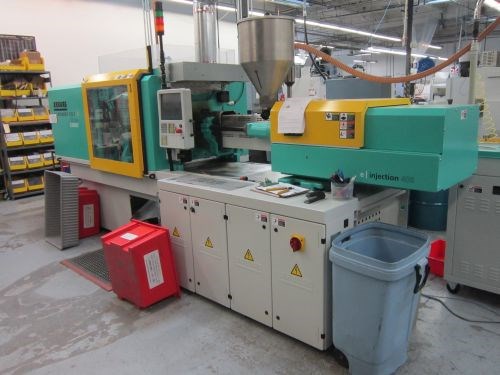Made in the U.S.A.
This OEM recently achieved the growth necessary to revamp its captive moldmaking and molding operation—and to bring nearly $1 million worth of tooling back from overseas.

Along with the changes detailed in this article, this 110-ton Arburg Allrounder injection press enabled Seescan to run larger production tooling in-house rather than sourcing it overseas.
Anyone who doubts U.S. companies’ ability to compete with low-cost overseas manufacturers should consider the example of Seescan. This San Diego-area OEM is midst of reshoring nearly $1 million worth of tooling it previously ran in China.
So says Kirk Joy, manager of the company’s captive mold manufacturing and molding operation. He adds that the move to bring the work back is in fitting with a larger trend at this manufacturer of equipment for locating and inspecting utilities. Exponential growth is the norm for Seescan—since 2009 alone, it’s gone from 97 employees and $15 million in annual revenue to 210 employees and $50 million in annual revenue. As the company grows, it continues to ramp up its in-house capability and expertise.
Most recently, that’s meant significant changes to the company’s captive moldmaking operation. With new, more sophisticated equipment, the company has the capability to perform work that once had to be outsourced, whether locally or across the pond. Meanwhile, a more collaborative, process-focused approach ensures the shop can make the most of new and old machinery alike, not to mention employees’ time. As a result, the shop has managed to reduce costs to the point where manufacturing in-house is more cost-effective than relying on overseas partners. “If you give your people the right equipment and they use it effectively, your labor rate goes down, and I’m not just talking about 5 or 10 percent—it’s huge,” Joy says. “We can do things with four people that less advanced shops can’t do with 10 people.”
The relevant changes to the captive moldmaking operation are detailed extensively in this September issue article. Suffice to say that letting newer, more sophisticated machinery run for entire shifts while employees stick to value-added tasks has proven more than enough to compete with Chinese partners, at least when accounting for all expenses involved (increasing labor costs in China, shipping costs and delays, uncertainty, and so forth). Strategies geared toward reducing setup time, which are detailed here, also contribute to the necessary time and cost savings. Moreover, changes weren’t limited to toolmaking. On the molding side, the company also purchased a 110-ton Arburg Allrounder 470E press. This addition was critical because most of work in China consisted of production molds that exceed the capacity of the shop’s 60-ton presses.
Joy emphasizes that the company hasn’t had any major problems with partners in China, and in fact, it still sources some work there today. Nonetheless, keeping as much work as possible in-house is particularly critical for Seescan because its success depends in large part on getting new products to market quickly. To that end, control over production is far preferable to being at the mercy of a distant operation with its own goals and priorities, particularly given that Seescan might have little recourse in the event of a problem. “If the manufacturer folds, that's potentially a lot of tooling that we probaby won't get back,” he says. Now, that uncertainty is far less worrisome.
Read Next
Are You a Moldmaker Considering 3D Printing? Consider the 3D Printing Workshop at NPE2024
Presentations will cover 3D printing for mold tooling, material innovation, product development, bridge production and full-scale, high-volume additive manufacturing.
Read MoreHow to Use Continuing Education to Remain Competitive in Moldmaking
Continued training helps moldmakers make tooling decisions and properly use the latest cutting tool to efficiently machine high-quality molds.
Read MoreHow to Use Strategic Planning Tools, Data to Manage the Human Side of Business
Q&A with Marion Wells, MMT EAB member and founder of Human Asset Management.
Read More.jpg;maxWidth=970;quality=90)














.png;maxWidth=300;quality=90)



.jpg;maxWidth=300;quality=90)



_970x250 3.png;maxWidth=970;quality=90)